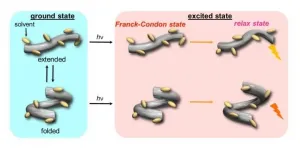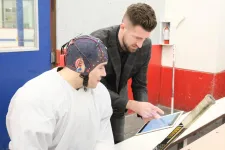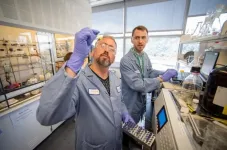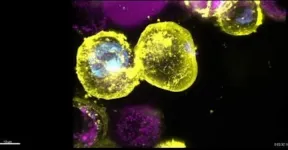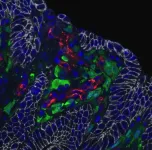(Press-News.org) Stimulus-responsive supramolecular structures have emerged as an alternative to conventional ones, owing to their applications in sensing, drug delivery, and switchable memory systems. Now, scientists at Tokyo Institute of Technology explore the hydrostatic-pressure response of "foldamers"--artificial molecules that mimic protein folding--and report a shift in their preferred conformation with changing pressure, demonstrating hydrostatic pressure-enabled dynamic control. The finding opens doors to future development of pressure-sensitive foldamers and artificial materials.
Most, if not all, biological systems are extremely complex and often rely on interactions traditional chemistry does not focus on. An entire field of research called "supramolecular chemistry" has been inspired to study exactly those interactions that govern biological processes, based on an approach relying on artificial "molecular machines" to mimic biological functions. These molecular machines are responsive to a wide range of external stimuli, such as temperature, surrounding media, excitation with light, and consequently find applications in sensing, drug delivery, molecular imaging, and switchable memory technology.
However, a particular stimulus--namely, hydrostatic pressure--has long been in fashion due to the remarkable fact that it allows a supramolecular material to be studied both in its unperturbed and pressurized state. In fact, a research group based in Japan, consisting of scientists from Tokyo Institute of Technology (Tokyo Tech), have recently shown that the optical properties and chemical processes in solutions of supramolecular materials can be precisely regulated by hydrostatic pressure.
Inspired by their findings, the group, led by Prof. Gaku Fukuhara from Tokyo Tech and Prof. Hiromitsu Maeda from Ritsumeikan University, moved on to study the effects of pressure on "foldamers"--artificial molecules that mimic proteins. Their findings were published in the journal Chemical Science (doi : 10.1039/D1SC00664A). The name "foldamer" derives from the fact that these systems can replicate proteins folding into well-defined patterns. Prof. Gaku Fukuhara explains the motivation for their study: "The solution-state behavior of foldamers under hydrostatic pressure has not been examined in detail, which poses a challenge to further advancements in supramolecular chemistry."
For a foldamer to fold into a specific conformation, it first needs to bind to a "guest" negatively charged ion that forms the racemic state (equal amount) of helical structures. The chirality (or the property of being distinct from its mirror image) of the resulting structure can then be induced by introducing an asymmetric counter positive ion, a process known as "ion pairing". The ion pairing, however, depends on the solvation conditions for the foldamer, which, in turn, can be influenced by hydrostatic pressure. Accordingly, scientists chose a fluorescent foldamer as a negative ion receptor, called a "host", and chiral ion pairs (such as chloride and bromide) as "guests" (Fig. 1) to explore the optical properties of the "host" solution under hydrostatic pressure.
The scientists began by examining the changes in fluorescence and absorption (in UV and visible) spectra for the host in various organic solvents under pressure and observed a gradual shift in the spectral band to longer wavelengths as well as an increased absorbance with rising pressure. They attributed this to the fact that the host initially adopts two conformers, one extended and one folded, and gradually shifts to an "extended-rich state" upon pressurization (Fig. 2, left). Then, after electronic excitation (hυ), two different fluorescence states were observed from these conformers (Fig. 2, right).
"Our study clearly shows that conformations in the flexible foldamer host can be dynamically controlled, in both ground and excited states, simply by changing hydrostatic pressure," comments an excited Prof. Fukuhara. "In fact, this strategy can even be extended to other foldamer and guest combinations that have difficulty sensing each other or do not show a host-guest chemistry," he adds.
The team's efforts at deciphering foldamers better certainly brings us one step closer to comprehending the complexity of proteins!
INFORMATION:
About Tokyo Institute of Technology
Tokyo Tech stands at the forefront of research and higher education as the leading university for science and technology in Japan. Tokyo Tech researchers excel in fields ranging from materials science to biology, computer science, and physics. Founded in 1881, Tokyo Tech hosts over 10,000 undergraduate and graduate students per year, who develop into scientific leaders and some of the most sought-after engineers in industry. Embodying the Japanese philosophy of "monotsukuri," meaning "technical ingenuity and innovation," the Tokyo Tech community strives to contribute to society through high-impact research.
https://www.titech.ac.jp/english/
About Ritsumeikan University, Japan
Established in 1869 with a spirit of liberalism and internationalism, Ritsumeikan University is one of the top-ranking universities in Japan; it was the first to be rated by Quacquarelli Symonds. The university now counts with three main campuses in Kyoto, Shiga and Osaka and boasts over 36,000 students. It is the No. 1 recommended destination for exchange students and even offers the opportunity to earn some degrees entirely in English. Its educational philosophy is based around peace and democracy, and the university strives to face the current era of rapid changes with a rich diversity of people and ideas.
http://en.ritsumei.ac.jp/
About Japan Science and Technology Agency (JST)
Japan Science and Technology Agency (JST), an advanced network-based research institute that promotes the state-of-the-art R&D projects, will boldly lead the way for co-creation of innovation for tomorrow's world together with society.
https://www.jst.go.jp/EN/
Animals use their sense of smell to navigate the world--to find food, sniff out mates and smell danger. But when a hungry animal smells food and a member of the opposite sex at the same time, what makes dinner the more attractive option? Exactly what is it about the odor of food that says, "Choose me?"
Research by investigators at Harvard Medical School illuminates the neurobiology that underlies food attraction and how hungry mice choose to pay attention to one object in their environment over another.
In their study, published March 3 in Nature, Stephen Liberles and co-author Nao Horio, identified the pathway that promotes attraction ...
STUDY SHOWS VACCINES MAY PROTECT AGAINST NEW COVID-19 STRAINS ... AND MAYBE THE COMMON COLD
A new study by Johns Hopkins Medicine researchers provides evidence that CD4+ T lymphocytes -- immune system cells also known as helper T cells -- produced by people who have received either of the two messenger RNA (mRNA) vaccines for COVID-19 caused by the original SARS-CoV-2 strain also will recognize the mutant variants of the coronavirus that are rapidly becoming the dominant types worldwide.
The researchers say this suggests that T cell responses elicited or enhanced by the vaccines should be able to control the current ...
Surrey, B.C. Canada and Rochester, Minn., U.S. (April 22, 2021) - Neuroscience researchers at Mayo Clinic Orthopedics and Sports Medicine in Rochester, Minnesota, U.S., the Health and Technology District and Simon Fraser University (SFU) in Surrey, British Columbia, Canada have published the latest results of their ongoing multi-year hockey concussion study examining changes in subconcussive cognitive brain function in male youth ice hockey players.
The research team monitored brain vital signs during pre- and post-season play in 23 Bantam (age 14 or under) and Junior A (age 16 to 20) male ice-hockey players in Rochester, Minnesota.
"Brain vital signs" translates complex ...
Plastics are a part of nearly every product we use on a daily basis. The average person in the U.S. generates about 100 kg of plastic waste per year, most of which goes straight to a landfill. A team led by Corinne Scown, Brett Helms, Jay Keasling, and Kristin Persson at Lawrence Berkeley National Laboratory (Berkeley Lab) set out to change that.
Less than two years ago, Helms announced the invention of a new plastic that could tackle the waste crisis head on. Called poly(diketoenamine), or PDK, the material has all the convenient properties of traditional plastics while avoiding the environmental pitfalls, because unlike traditional plastics, PDKs can be recycled indefinitely ...
Living away from community and country, Aboriginal families of children with severe burns also face critical financial stress to cover the associated costs of health care and treatment, a new study shows.
An Australian study, led by Flinders researchers Dr Courtney Ryder and Associate Professor Tamara Mackean, found feelings of crisis were common in Aboriginal families with children suffering severe burns, with one family reporting skipping meals and others selling assets to reduce costs while in hospital.
The economic hardship was found to be worse in families who live in rural areas - some households travelling more ...
Rising levels of dementia is putting pressure on residential aged care facilities, including in rural and regional centres where nursing homes and staff are already under pressure.
Now a pilot program of personalised interventions, including residents' favourite songs, has been shown to make a big difference to dementia behaviours, drug use and carers' wellbeing.
Harmony in the Bush, a study led by Flinders University in five nursing homes in Queensland and South Australia, developed a multimodal person-centred non-pharmacological intervention program incorporating ...
A new molecular 'freeze frame' technique has allowed WEHI researchers to see key steps in how the protein MLKL kills cells.
Small proteins called 'monobodies' were used to freeze MLKL at different stages as it moved from a dormant to an activated state, a key process that enables an inflammatory form of cell death called necroptosis. The team were able to map how the three-dimensional structure of MLKL changed, revealing potential target sites that might be targets for drugs - a potential new approach to blocking necroptosis as a treatment for inflammatory diseases.
The research, which ...
IL-11 is known to promote the development of colorectal cancer in humans and mice, but when and where IL-11 is expressed during cancer development is unknown. "To address these questions experimentally, we generated reporter mice that express the green fluorescent protein (EGFP) gene in interleukin 11 (IL-11)-producing (IL11+) cells in vivo. We found IL-11+ cells in the colons of this murine colitis-associated colorectal cancer model," said Dr. Nishina, the lead author of a study published April 16 in Nature Communications. "The IL-11+ cells were absent from the colon under normal conditions but rapidly appeared in the tissues of mice with colitis and colorectal cancer."
In the study, Dr. Nishina and colleagues characterized the IL-11+ cells by flow cytometry and found that ...
The human immune defense is based on the ability of white blood cells to accurately identify disease-causing pathogens and to initiate a defense reaction against them. The immune defense is able to recall the pathogens it has encountered previously, on which, for example, the effectiveness of vaccines is based. Thus, the immune defense the most accurate patient record system that carries a history of all pathogens an individual has faced. This information however has previously been difficult to obtain from patient samples.
The learning immune system can be roughly divided into two parts, of which B cells are responsible for producing antibodies against pathogens, while T cells are responsible for destroying their targets. The measurement of antibodies by traditional laboratory ...
The study was published by the team from Ruhr-Universität Bochum (RUB), the Max Planck Institutes of Biochemistry and Biophysics, the Center for Synthetic Microbiology (SYNMIKRO) and the Chemistry Department at Philipps Universität Marburg, the University of Illinois Urbana-Champaign, USA, and Université Paris-Saclay, France, online on 12 April 2021 in the journal Nature Plants.
Catalyst of life
Photosystem II (PS II) is of fundamental importance for life, as it is able to catalyse the splitting of water. The oxygen released in this reaction allows us to breathe. In addition, PS II converts light energy ...
